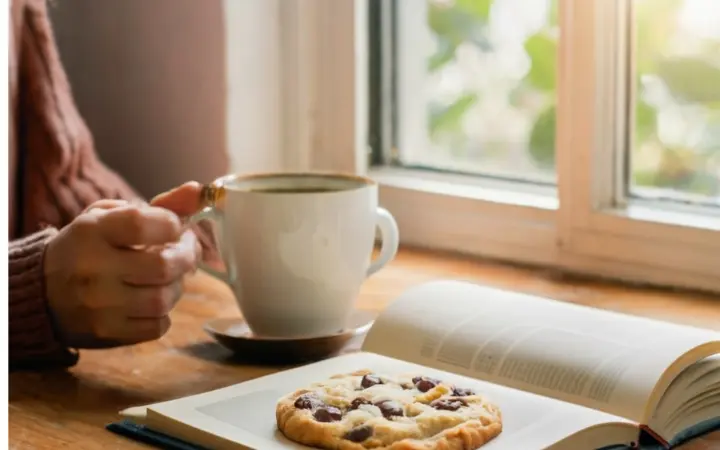Introduction to Chocolate Chip Cookies
The chocolate chip cookie, a seemingly simple yet profoundly impactful staple in baking, captivates hearts with its perfect harmony of sweetness and texture, endearing itself to people of all ages. What is it about this cookie that elevates it to such widespread acclaim?
More than just a delightful snack, chocolate chip cookies symbolize a cultural legacy. They stir feelings of nostalgia, comfort, and happiness, often reminiscent of cozy family gatherings or relaxing Sunday afternoons. Their allure lies in their adaptability – whether you crave the gooey softness or a crisp bite, there’s a version for every taste preference.
Their popularity isn’t solely attributed to their delicious taste. It’s also their straightforward preparation that contributes to their widespread appeal. The basic ingredients – flour, sugar, butter, and chocolate chips – are staples in most kitchens, allowing almost anyone to bake these delightful treats with ease.
Yet, the simplicity of chocolate chip cookies belies a deeper complexity. Each ingredient is pivotal, with even minor variations capable of producing significantly different outcomes. Mastery of these subtleties is essential for anyone aspiring to bake the perfect chocolate chip cookie.
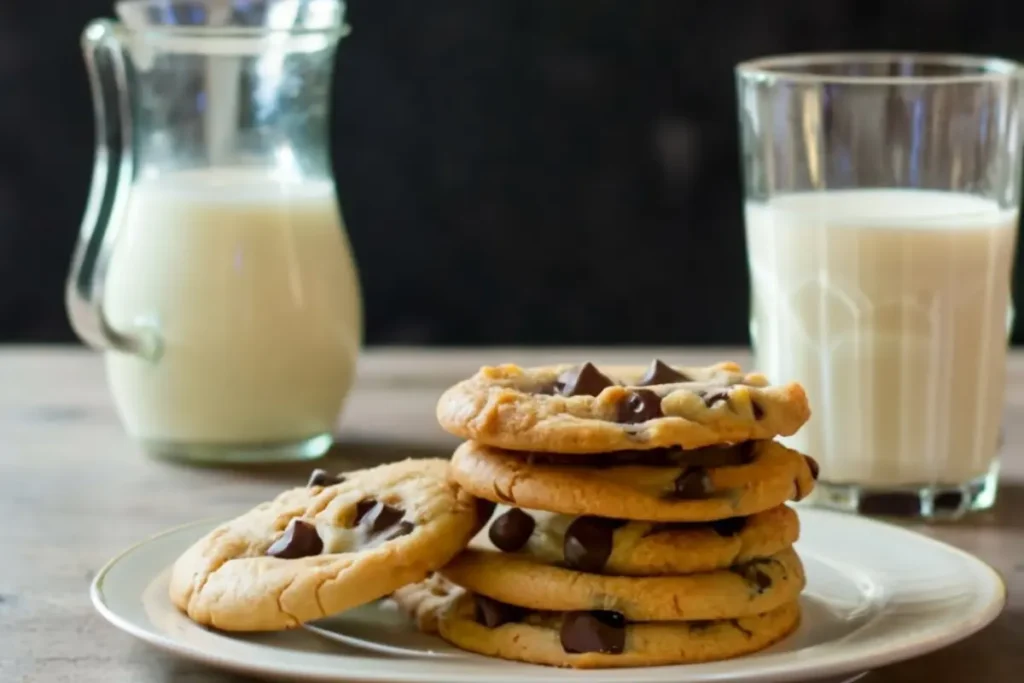
The History and Evolution of Chocolate Chip Cookies
The Origin Story
The narrative of the chocolate chip cookie is as layered and rich as the cookie itself. It all commenced in 1938 at a charming establishment in Massachusetts, the Toll House Inn. Here, Ruth Wakefield, a talented baker and owner, embarked on an innovative culinary experiment that would revolutionize the confectionary world.
As the story goes, Ruth’s ingenious addition of chopped Nestle chocolate to her butterscotch cookie dough, expecting it to melt and blend, resulted in an unexpected outcome. The chocolate retained its shape, offering a delightful textural contrast in each bite. This fortunate accident gave rise to the Toll House Crunch Cookie, soon to become a staple in households nationwide. Delve into the historical origins of the chocolate chip cookie.
Ruth Wakefield and the Toll House Inn
Ruth Wakefield’s impact on baking is monumental. Her creativity and culinary skill led to a creation that transcended the confines of the Toll House Inn. The widespread acclaim of her cookies eventually led to the inclusion of her recipe on Nestle chocolate bar wrappers, earning her a lifetime supply of chocolate. This marked the beginning of the chocolate chip cookie’s endearing journey into the hearts and homes of millions.
Evolution of the Recipe
Over time, the original Toll House recipe has seen numerous adaptations and variations. Each baker adds a personal touch, experimenting with various types of chocolate, tweaking ingredient ratios, and adjusting baking times and temperatures.
A notable development in the cookie’s evolution was the introduction of the Jacques Torres recipe, as featured in a significant New York Times article. This recipe, with reduced butter and egg quantities, led to a richer, more indulgent cookie with less spread, reflecting a shift towards more luxurious versions of the classic cookie.
Understanding Chocolate Chip Cookie Varieties
Exploring Different Cookie Species
The world of chocolate chip cookies is marked by its diversity. Across the United States, regional differences have led to the emergence of unique cookie ‘species’, each with its own devoted fan base. The range of textures and flavors, from thin and crispy to thick and gooey, is remarkably broad. Explore regional chocolate chip cookie varieties across the U.S..
East Coast vs. West Coast Styles
In New York City, the East Coast style of chocolate chip cookies is notably grandiose. The Levain Bakery style, in particular, is renowned for its massive, almost scone-like cookies, characterized by their substantial size and moist, underbaked centers.
In contrast, the West Coast, notably in cities like Los Angeles, favors a thinner, crisper style. These cookies are typically broader, emphasizing a buttery, caramelized flavor and a satisfying crunch. Often, they include oats, adding another layer of complexity to their flavor profile.
The Spectrum of Cookie Textures
The texture of a chocolate chip cookie can vary significantly based on the ratios of ingredients and the methods used in baking. At one end of the spectrum are the thick, cake-like cookies, soft and almost bread-like in texture. Progressing further, you encounter the chewy variety, offering a pleasant balance of softness and resistance.
Continuing along the spectrum, the cookies become increasingly crunchy, providing a delightful snap. At the opposite extreme are the thin, crispy cookies, defined by their crunch and rich, caramelized sugar flavors.
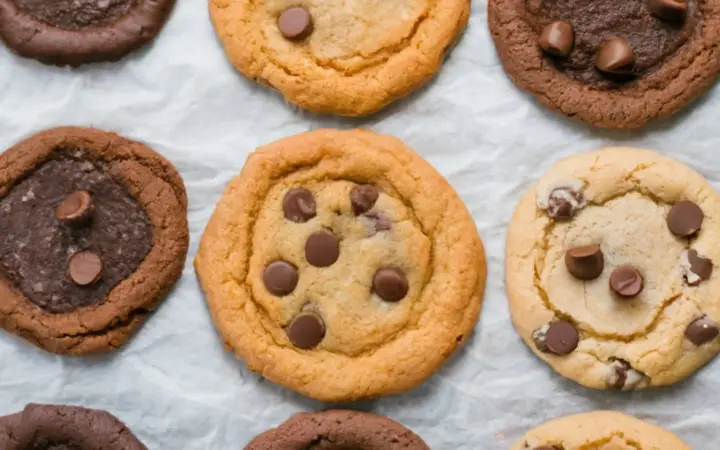
Ingredients and Their Impact on Chocolate Chip Cookies
Choosing the Right Ingredients
The path to the perfect chocolate chip cookie begins with the selection of appropriate ingredients. Each component, from the flour to the chocolate, significantly influences the final texture and flavor of the cookie. Learn how to select the best ingredients for chocolate chip cookies.
Flour provides the structural foundation of the cookie. While all-purpose flour is commonly used, variations like bread flour or a blend of flours can modify the texture, making it either chewier or crisper. The choice of sugar also plays a crucial role. Brown sugar contributes moisture and a deep molasses flavor, resulting in a chewier cookie, whereas white sugar encourages crispiness and spread.
Butter is essential for richness and flavor. Its state – whether melted, softened, or cold – directly affects the texture of the cookie. Melted butter typically leads to a denser, chewier cookie, while creamed butter tends to produce a lighter, more cake-like texture
The Importance of Mix-ins
Mix-ins such as chocolate chips, nuts, and oats are not mere extras; they are integral to the character of the cookie. The decision between chocolate chips and chunks can significantly alter the end result. Chips, often containing stabilizers, maintain their shape, providing a consistent chocolate experience. Conversely, hand-chopped chocolate melts unevenly, creating pockets of molten chocolate throughout the cookie.
Nuts add a crunchy texture and a nutty flavor, complementing the sweetness of the dough. Oats contribute a chewy texture and a subtle, earthy flavor. The type and quantity of mix-ins can transform a basic cookie into a complex, multi-textured delight.
Chocolate Chips: Store-Bought vs. Hand-Chopped
The choice between store-bought chocolate chips and hand-chopped chocolate boils down to personal preference and the desired outcome. Store-bought chips offer convenience and uniformity in shape and melting. On the other hand, hand-chopping chocolate from a high-quality bar can elevate the cookie to a gourmet level. The varied sizes of the chocolate pieces create an intriguing texture and a more intense chocolate flavor. This variation also means that each bite is unique – some may be richly laden with chocolate, while others offer a subtler taste. Learn about choosing the right chocolate for your cookies.
The type of chocolate used – be it dark, milk, or semi-sweet – significantly impacts the cookie’s overall flavor profile. Dark chocolate provides a deep, intense chocolate flavor with less sweetness, while milk chocolate offers a creamier, milder taste.

The Baking Process of Chocolate Chip Cookies
To Rest or Not to Rest the Dough
A topic of much debate among chocolate chip cookie aficionados is whether to rest the dough before baking. Resting the dough in the refrigerator can significantly affect the texture and flavor of the cookies. Understand the benefits of resting cookie dough.
Not all cookie recipes, however, benefit from a resting period. For thinner, crispier cookies, immediate baking can maintain the spread and crisp texture, as the butter remains softer. Conversely, for thicker, chewier cookies, resting the dough can solidify the fats, reducing spread and yielding a denser texture.
The Impact of Resting on Texture
Resting the dough can transform the texture of your cookies. A longer rest, ranging from 24 to 72 hours, can result in chewier, more substantial cookies. The dough becomes drier, allowing the sugars more time to dissolve and develop a complex flavor profile.
For those who prefer a cookie with a delicate, tender crumb, a shorter rest or no rest might be preferable. This method can produce cookies that are soft and light, with a more immediate, straightforward sweetness.
Shaping Your Cookies for Perfection
The method of shaping your cookie dough also plays a crucial role in the final outcome. For a rustic, homemade appearance, roughly shaped balls of dough can create an uneven texture with peaks and valleys that brown attractively in the oven.
For a more uniform, professional look, using a cookie scoop or rolling the dough into smooth balls ensures consistent size and shape. This technique is especially useful for achieving evenly baked cookies, particularly if a crispier texture is desired.
The size of your cookie dough balls is also important. Larger balls will produce thicker, softer cookies, while smaller balls will result in thinner, crisper cookies. Adjusting the size according to your preference allows you to control the texture and size of your final product.
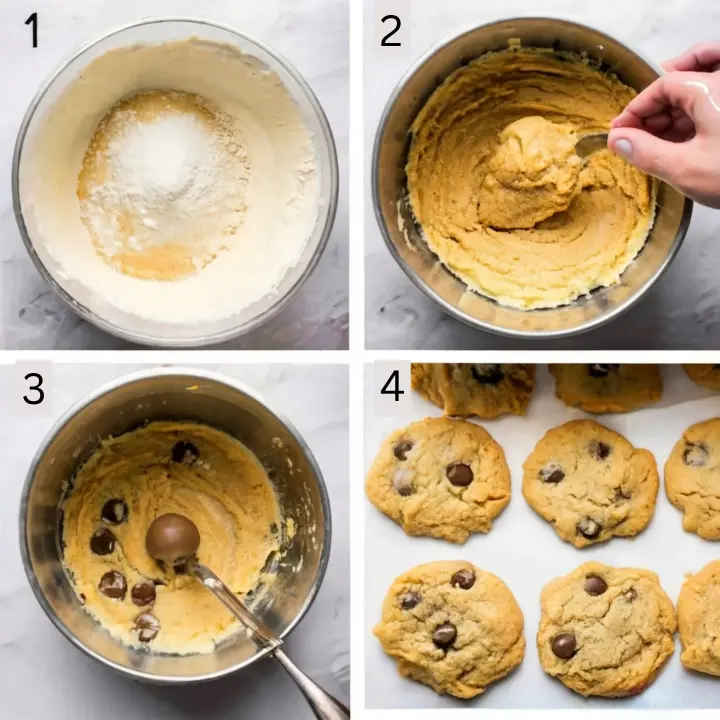
Advanced Baking Techniques for Chocolate Chip Cookies
Mastering Raising Agents
In the art of baking chocolate chip cookies, the choice and use of raising agents, especially baking soda, are crucial. Understanding how these agents function can significantly elevate the quality of your cookies. Master the use of baking soda in chocolate chip cookies.
Baking soda reacts with acidic components in the cookie dough, like brown sugar and chocolate, releasing carbon dioxide. This reaction causes the dough to rise and spread, influencing the cookie’s texture. The correct amount of baking soda is vital; too little may result in dense, flat cookies, while too much can cause them to rise too quickly and then fall, leading to a crumbly texture.
Baking Soda: A Key Ingredient
Baking soda not only affects the rise but also contributes to the color and flavor of the cookie. It encourages browning through the Maillard reaction, resulting in a rich, golden hue and a complex flavor profile. The challenge is to find the right balance – sufficient baking soda to create lift and browning, but not so much that it imparts an overly porous texture or a soapy taste.
The timing of adding baking soda is also critical. It should be mixed with the dry ingredients to ensure even distribution throughout the dough. Adding it too late can lead to uneven rising and an inconsistent texture.
The Role of Eggs
Eggs are another vital component in cookie dough, acting as a binding agent and providing structure and richness. The proportion of eggs used can alter the texture of the cookie. More eggs tend to result in a cakier, softer cookie, while fewer eggs lead to a denser, chewier texture.
The method of incorporating the eggs into the dough is also significant. Fully integrating and emulsifying the eggs with the butter and sugar creates a uniform texture. However, over-mixing can introduce excessive air into the dough, causing the cookies to rise and then collapse.
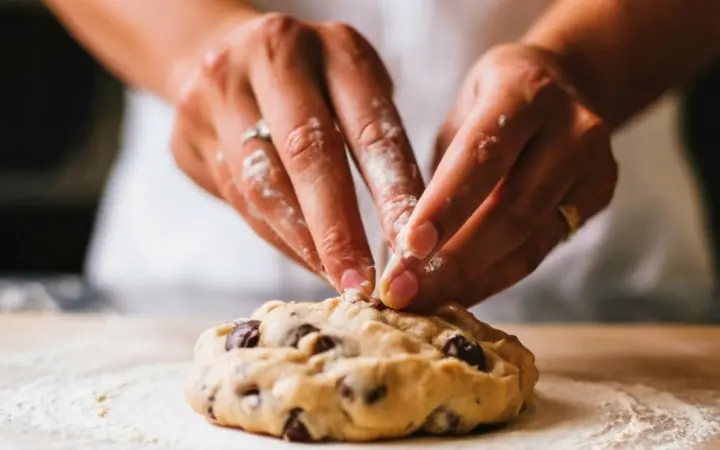
Frequently Asked Questions
Best Chocolate for Chocolate Chip Cookies?
Selecting the ideal chocolate is crucial for crafting the perfect chocolate chip cookies. The choice largely depends on personal preference. For a deeper, more intense flavor, opt for dark chocolate with a higher cocoa content. For a sweeter, creamier taste, milk chocolate is an excellent choice. Semi-sweet chocolate, balancing bitterness and sweetness, remains a classic option. The quality of the chocolate also matters significantly – choosing a high-quality brand can greatly enhance the flavor of your cookies. Best Chocolate for Chocolate Chip Cookies.
How to Achieve the Perfect Cookie Texture?
Achieving the ideal texture in chocolate chip cookies requires a careful balance of ingredients and baking techniques. For chewier cookies, increase the proportion of brown sugar and consider adding an extra egg yolk. For crispier cookies, use more white sugar and possibly melted butter. Baking time and temperature are also crucial – a higher temperature for a shorter duration results in a crisper edge, while a lower temperature for a longer period yields a softer cookie.
